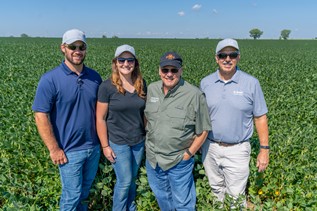“Talking Todes Together with BASF” video series highlights how farmers can actively manage SCN.

Soybean cyst nematode (SCN) is a stealthy thief, robbing yields from seemingly healthy fields. “Our yields seemed to stagnate in that 55 to 60 bushel an acre range. Explosive yields for some fields showed we had good genetics, but we didn’t have the consistency across our acres to pull up the average,” says Dan Ory, a fifth-generation farmer in southwest Iowa. “We knew we had issues with sudden death syndrome (SDS). We dug deeper and realized we had problems with SCN.”
SCN is widely distributed across the Midwest. But due to the lack of visible symptoms and because the pathogen had for decades been suppressed by the PI 88788 source of SCN resistance, farmers like Ory weren’t actively managing it.
To build awareness about SCN’s $1.5 billion annual toll and how farmers can protect soybean yields, The SCN Coalition and BASF Agricultural Solutions partnered on a video series featuring Ory, Iowa State University Nematologist Greg Tylka and BASF Senior Field Technical Representative for Seed Treatment for the Western Corn Belt Troy Bauer.
This isn’t the Orys’ first battle with SCN
“We’ve had SCN problems with beans in the past,” Ory says, referencing a soybean field that his dad and uncle farmed for 40 years. “Even though it had one of their best CSRs [corn suitability ratings], they could not obtain the soybean yields they had on other farms. They found one of the first genetic lines that had the PI 88788 source of SCN resistance. They pushed the yield envelope by implementing that new technology.”
But after decades of use, SCN has developed resistance to PI 88788, which is used in more than 95% of SCN-resistant varieties in Iowa. Consequently, farmers like Ory are now battling the same pathogen their parents did.
Ory suspected some of his fields had issues with SCN, but the degree of pressure revealed by soil tests was eye-opening. “We had counts as high as 9,000, and we had counts as low as 1,000,” Ory says, noting the highest SCN population densities came in a field along a heavily trafficked gravel road with high soil pH.
Fighting SCN and pushing boundaries to ensure the longevity of the Ory farm
The Ory family manages SCN by soil sampling in the fall, keeping fields in a rotation between corn and soybeans, planting SCN-resistant varieties (including varieties with the Peking SCN resistance trait, when possible) and using a nematode-protectant seed treatment. “ILEVO® is our preferred seed treatment,” Ory says. His trials indicate the seed treatment has pushed yields and diminished SDS.
“Our goal moving forward is to continue to push boundaries and stay on the cutting edge with genetics, treatments and technology to make sure we’re relevant and sustainable 10, 20 and 30 years down the road,” Ory says. “I believe a true sustainable farm shows profit,” Ory continues. “You continue to improve soil health, air quality, water quality and the area around you by implementing new technologies, by finding new ways to do things that don’t hurt the bottom line.”
Ory, who farms with his wife and brother, concludes, “If one of our three children or my brother’s children would like to farm, we want to have the opportunity to present it to them.”
To learn more about the Ory family and their fight against SCN, check out the video series. For more information about managing SCN, visit thescncoalition.com.


















